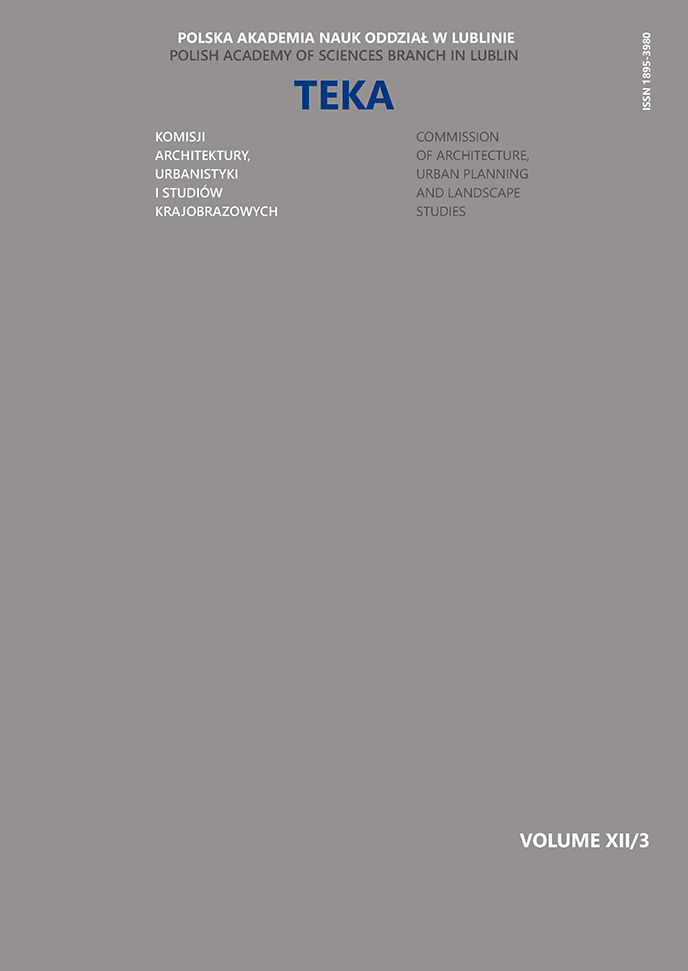Universal design versus raising the level of accessibility of hospital facilities
Article Sidebar
Open full text
Issue Vol. 12 No. 3 (2016)
-
Rozwój struktury przestrzenno-planistycznej historycznego miasta Mikulińce
Zoriana Łukomska7-12
-
Wybrane aspekty projektowania przestrzeni publicznych z uwzględnieniem potrzeb seniorów
Natalia Przesmycka, Michał Dmitruk13-20
-
Środowisko człowieka i jego percepcja – kształtowanie przyjaznych oraz nieprzyjaznych przestrzeni mieszkalnych
Wojciech Kocki, Jacek Bogucki, Wioletta Tuszyńska-Bogucka, Jarosław Pełka, Bartłomiej Kwiatkowski21-28
-
Universal design versus raising the level of accessibility of hospital facilities
Joanna Borowczyk29-38
-
41 Cooper Union Square – save architecture, generative architecture
Sławomir Wojtkiewicz39-50
-
Dzieci w mieście – wyzwania i potrzeby dziecka jako użytkownika przestrzeni publicznej
Natalia Przesmycka51-61
-
Method of calculation and nomenclature of new types of educational complexes “kindergarten – elementary school” within the housing development
Olha Homon62-69
-
Spaces and Buildings of Passenger Transport in Wrocław in the Context of Cultural and Social Events
Wojciech Jabłoński70-80
-
Self-contained flats in a multi- divided town house. Comfort rating based on current technical law and regulations in building
Wojciech Matys81-90
-
Safe soundscape in the spa park based on its development plan
Małgorzata Sztubecka, Maria Mrówczyńska, Anna Bazan-Krzywoszańska, Marta Skiba91-101
Archives
-
Vol. 16 No. 4
2020-12-30 11
-
Vol. 16 No. 3
2020-09-30 10
-
Vol. 16 No. 2
2020-06-30 11
-
Vol. 16 No. 1
2020-03-31 10
-
Vol. 14 No. 3
2018-10-28 14
-
Vol. 14 No. 2
2018-06-29 14
-
Vol. 14 No. 1
2018-03-30 13
-
Vol. 13 No. 4
2017-12-29 8
-
Vol. 13 No. 3
2017-09-29 9
-
Vol. 13 No. 2
2017-06-30 10
-
Vol. 13 No. 1
2017-03-31 10
-
Vol. 12 No. 4
2016-12-30 12
-
Vol. 12 No. 3
2016-09-30 10
-
Vol. 12 No. 2
2016-06-30 9
-
Vol. 12 No. 1
2016-03-31 8
-
Vol. 11 No. 4
2015-12-30 14
-
Vol. 11 No. 3
2015-09-30 7
-
Vol. 11 No. 2
2015-06-30 8
-
Vol. 11 No. 1
2015-03-31 11
Main Article Content
DOI
Authors
Abstract
The contemporary architectural discourse puts an increasing emphasis on meeting the needs and expectations of persons with disabilities. Poland has been obliged to implement the regulations included in the Convention on the Rights of Persons with Disabilities in order to provide all the citizens with the highest standards and unlimited access to health care services. Thus it is necessary to answer the question of how to design buildings and medical services so that they follow the principles included in Art.25 of the Convention. Complex restructuring which covers the needs of all hospital users could become a crucial activity in developing a novel approach and setting new directions for the changes in the design and building of health care facilities.
Keywords:
References
Forty A. Words and Buildings. Thames and Hudson, London, 2000.
Kuryłowicz E. Uniwersalność rozwiązań architektonicznych w kontekście otwierania środowiska wybudowanego dla wszystkich, jako wyraz i efekt postawy innowacyjnej – normalność w architekturze. Studia BAS 2/42 (2015) 203−217.
Kuryłowicz E. Projektowanie uniwersalne przestrzeni – doświadczenia polskie i międzynarodowe, perspektywy dla edukacji. Referat. Konferencja Projektowanie uniwersalne. Dostępność i uczestnictwo dla wszystkich, Warszawa, 2012.
Rezolucja ONZ nr 61/06 z dnia 13 grudnia 2006: Konwencja Praw Osób Niepełnosprawnych (ang. Convention on the Rights of Persons with Disabilities). A/RES/61/106.
Wysocki M. i in. Realizacja zasady równości szans i niedyskryminacji, w tym dostępności dla osób z niepełnosprawnościami. Ministerstwo Rozwoju, Warszawa, 2015.
Wysocki M. Budowa Miasta Przyjaznego na przykładzie Miasta Gdyni. Referat. Łódzki Konwent Regionalny II Kongresu Osób z Niepełnosprawnościami, Łódź, 2016.
Stępień B. Standard dostępności dla Łodzi. Referat. Łódzki Konwent Regionalny II Kongresu Osób z Niepełnosprawnościami, Łódź, 2016.
Easy Access to Historic Buildings. Historic England, London [https://www.visitengland.com/sites/default/files/historic_england_easy_access_to_historic_buildings_2015.pdf, dostęp: 04.05.2016].
Truesdale S., Steinfeld E. Visit-ability an approach to Universal Design in housing. Rehabilitation Engineering Research Center on Universal Design at Buffalo, School of Architecture and Planning University at Buffalo The State University of New York, 2002.
Projektowanie uniwersalne - Objaśnienie koncepcji, 2007. Ministerstwo Ochrony Środowiska Norwegia, Biuro Pełnomocnika Rządu ds. Osób Niepełnosprawnych, Ministerstwo Pracy i Polityki Społecznej, Warszawa [http://niepelnosprawni.gov.pl/container/publikacje/projektowanie-uniwersalne/projektowanie-uniwersalne.%20Objasnienie%20koncepcji.pdf, dostęp: 06.07.2016].
Article Details
Abstract views: 320


